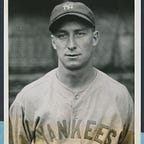Wednesday, June 29, 1927: New York City
Saving Shocker’s Game
 Urban Shocker may be dying, but on the mound he’s thriving. Who knows how much time on earth Shock has left, but in the meantime he’s going to take down as many American League batters as he possibly can.
Urban Shocker may be dying, but on the mound he’s thriving. Who knows how much time on earth Shock has left, but in the meantime he’s going to take down as many American League batters as he possibly can.
Going into yesterday’s game Shock was 8–4 with a 2.78 ERA, with eight complete games, including five in his last six starts. Only Schoolboy has thrown more innings on our pitching staff, and only Schoolboy and Cy Moore have lower ERAs — which is saying something since there are five pitchers on the team with ERAs below three (including yours truly).
As difficult as Shock’s survival has become — having to be propped up in his bed each night by Eddie Bennett, to avoid fluid seeping into his lungs — he must find solace in the fits he gives batters who swing over, around and through his pitches.
Yesterday, Shock’s performance on the mound against the suddenly surging A’s — who had won five in a row, including three straight against us to start this series — seemed to be no exception.
From the bench I have a great view of Shocker’s game. While Sailor Bob acts as a coach to the younger players, helping them adjust to the challenge of pitching to big league hitters — and as a knowledgeable companion and sounding board to the older pitchers on the team — you can learn as much just by watching Shock work.
Unlike Schoolboy, who pitches with an arrogance and adrenaline, Shocker is always thinking at least one pitch ahead — sometimes two or even three — and the same number of at bats — armed with the knowledge he’s gleaned from his fastidious studying of newspaper box scores.
Of course, there are things that you can’t learn from Shocker, too. Like how to break your finger just the right way.
Shock started his career in the minors as a pitcher who caught during his off-days, which is why he mostly calls his own game from the mound. One day when Shock was behind the plate, he made the fortunate mistake of trying to stop a wild pitch with his throwing hand, instead of using his catcher’s mitt; the result was a broken middle finger. His minor league team’s doctor didn’t set the break right, and Shock’s finger mended with a permanent curl at the first knuckle. Back on the mound, Shock discovered that his newly mended finger hooked the ball in a way that gave his pitches a unique spin — like a spitball without the spit. Shortly thereafter, he made the transition to full-time pitcher.
“Sometimes when I watch him on the mound,” Schoolboy said to me earlier this month during a Shocker masterpiece against St. Louis, “I want to go into the clubhouse and ask Doc Woods to get a hammer and break my middle finger.”
Crooked finger and dry spitball aside, what really makes Shocker special is his wet spitball. When the pitch was banned in 1919, sixteen other pitchers were grandfathered in and granted permission to keep throwing it. But now eight years later, Shocker’s the only one of the eight left who can still really command it. And because it doesn’t take as much effort to throw the spitball — and in Shocker’s case it’s amplified by his gimmick finger — Shock frequently gets stronger as the game goes on.
That’s why today, after Shock works out of some early inning trouble and Murderers’ Row spots him a six run cushion, we’re certain in the dugout that he’s on his way to his ninth complete game of the season — and a shutout to boot.
With two outs in the eighth, Shock is still rolling. Going back to the fourth inning he’s retired 13 consecutive A’s hitters — and only allowed one ball to leave the infield. His pitches, both wet and dry, are dancing over and around the plate and the hapless A’s flailing at Shocker’s offerings have the look of fish at the bottom of the bucket.
On his final pitch of the inning — a truly cruel spitter that plummets earthward just before it reaches the plate — Walt French lunges for it and lifts a lazy fly ball to left, which Meusel settles under.
Our whole dugout follows the flight of the ball as it floats into Meusel’s glove, but my eyes stay fixed on Shocker. Something about the way he moves as the ball comes out of his hand catches my eye, and now — with everyone still looking out at Meusel — I’m the only one who sees Shocker every so briefly grab at his chest, up by where his left arm meets his shoulder. It’s an almost involuntary motion on his part, a response to a fleeting stab of pain, which is quickly replaced by a much worse reality that’s reflected on his face. It’s fleeting, but it’s there. Fear.
As quickly as Urban grabs at his jersey, he just as quickly releases it and lets his arm fall to his side. By the time everyone’s attention has returned to Shocker his face betrays nothing of what’s just happened — and what’s surely still happening inside him.
It turns out I’m not the only one who’s noticed something’s wrong with Urban. After Shock gets back to the dugout, Miller Huggins pulls him aside for a quick conversation. From down at the other end of the dugout I see Shocker trying to fend off Huggins with a nod of his head and a wave of his hand.
Huggins apparently accepts Shocker’s version of events because, after the the heart of Murderers’ Row pushes three more across the plate to give us a 9–0 lead, Hugg sends Shocker out for the top of the ninth and a chance to go the distance.
And then it all goes very, very wrong.
 Shock isn’t right. After scattering four Philadelphia hits through the first eight innings, he gives up five straight hits to start the ninth.
Shock isn’t right. After scattering four Philadelphia hits through the first eight innings, he gives up five straight hits to start the ninth.
Even before Huggins finally goes to get him you can tell that Shocker’s body is barely on the mound — and his mind is somewhere else entirely. Not only is he not thinking two or three batters ahead, I don’t think he’s even thinking about the batter at the plate.
The game, which for eight innings was an Urban Shocker gem is now a Cy Moore mop up. Urban doesn’t hang around to see what becomes of his game; he walks off the mound, down the dugout steps and directly into the locker room.
I think about following after him, but I want to give him some time. I can check up on him after Cy Moore finishes off the game.
Only Moore doesn’t finish the game. A sinker ball pitcher, Cy gives up two straight hits on pitches that don’t have an ounce of sink — and Huggins gives him the quick hook.
Then Hugg, for the second day in a row, brings in Herb Pennock to stifle an A’s rally in the bottom of the ninth. Pennock is a total workhorse, he’s already thrown 10 complete games in 12 starts, and this is his third relief appearance.
I’m a little surprised that Huggins is bringing him in ahead of me, since Herb pitched yesterday. Huggins, though, obviously thinks Pennock, who’s a lefty, is a better matchup against the A’s next three batters, all of whom are lefties. But Pennock isn’t sharp, and two more runs score on a sacrifice fly, a walk and an error.
Less than 15 minutes ago we had a 9–0 lead going into the top of the ninth, and now we’re desperately trying to hold on to a one-run game: The tying runner is standing on first, with only one out, and two of baseball’s most dangerous hitters are due up next.
With the game in the balance and the right-handed Al Simmons now walking to the plate, Huggins heads back out to the mound, and this time he’s got me in tow.
Yankee Stadium has gone silent with the kind of malaise that settles over a crowd when they’ve been rattled and they’re no longer feeling like they’re backing a sure thing.
As I toss my warm up pitches, I do my best not to think about Urban Shocker. (Is he still in the locker room? Could he be in a hospital? If so, which one?) I need to focus only on the batter in front of me: Al Simmons.
Ty Cobb is past his prime. Same with Eddie Collins. But Al Simmons, in his fourth season, is a 25-year-old phenom whose prime is now. Two seasons ago he had 253 hits, the second most ever, then last year he batted .341 with 110 RBIs and 53 doubles. Right now, there aren’t five hitters in all of baseball better than Simmons — in the American League it’s only Ruth and Gehrig. This season Simmons is hitting almost .380 and earlier this inning, batting against Shocker, Simmons banged a triple off the wall in right center.
As Huggins leaves the hill and hands me the ball, Tony Lazzeri says to me, “This guy is a big fucking problem.”
“You think so?” I reply.
“Yeah. I think so. I also think he thinks you’re a small problem. He’s a hot head, so fuck with him. Brush him back. Then fork him.”
I follow the W*p’s advice.
Simmons is so livid that I have the nerve to throw my first pitch at his head that he lunges after my second toss, a nasty, diving forkball, and flies out to Combs in center. Two outs.
Next up, the A’s brilliant catcher, Mickey Cochrane. (“If we had him in our line up,” my roomie Bennie Bengough said to me earlier in the game, “I don’t think we’d lose 20 games all season.” That’s high praise from one of our catchers.)
As I’m thinking about what to throw Cochrane, Lazzeri calls time out.
“What the fuck are you doing?”
“I’m thinking about what to thro — ”
“Fork him. Fork the motherfucker and let’s get out of here.”
Lazzeri is right again. One forkball is all it takes, as Cochrane hits a hard grounder to Morehart to end the inning and the game.
Two up — two of the best players in the game — and two down.
So much for treading water.
